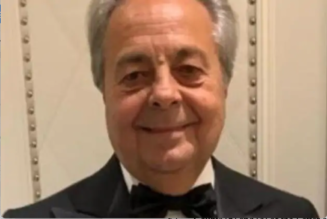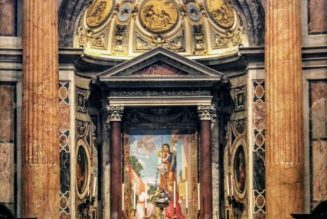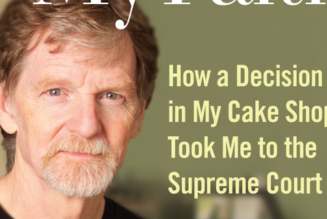
Worldwide, two people die every second. Here in the U.S., about 2.5 million die every year. And all those bodies take up a lot of space!
That’s the concern addressed by Archbishop Michael Jackels of Dubuque, Iowa, in an Oct. 20 message to the faithful of the archdiocese. Burial practices, the archbishop notes, are a significant environmental issue. For that reason, he encourages the acceptance of alternative methods of disposing of bodies, including alkaline hydrolysis and recompositing.
Basically, the alternative corpse disposal system works like this:
- Your soft tissues are melted down into a thick, syrupy paste; then
- along with standard waste, the paste could be dumped into the sewer system, or
- used as a high-protein fertilizer to energize crops.
- Your bones could be ground up, then
- returned to the family, like ashes to be scattered.
To be sure, Archbishop Jackels is well-intentioned. He cites environmental concerns that accompany the traditional burial methods, then explains why the other, more controversial methods can help to alleviate these problems.
The Archbishop’s Concern About Traditional Burial Methods
In-ground burial, Archbishop Jackels notes, is expensive and requires a lot of land. Here in the U.S., over the next 20 years, cemeteries will fill more than 130 square miles. Production of caskets uses natural resources, the ground is filled with concrete vaults, and ground water, he says, is polluted with embalming waste.
And he worries that cremation, while less costly, poses other problems: A single cremation uses about 30 gallons of fuel, and both the burning and the body itself release pollutants into the air.
Archbishop Jackels seems to see “green burial” — burial without use of embalming fluid, in a biodegradable container with no headstone — as a partial solution. But even then, he notes, the burial uses up land.
Are We Really Out of Room?
“Why the concern for land use?” I wondered, reading the archbishop’s letter. “Is Dubuque a very crowded area?” Not really. The population density as of the 2010 census was 1,923 inhabitants per square mile — pretty insignificant, when compared to New York City’s population density of almost 28,000 residents per square mile. And a 2015 Washington Postsurvey reported that the entire population of the world, more than 7.3 billion humans, could fit into New York City.
Archbishop Jackels’ concern for the environment seems to be the catalyst for his apparent endorsement of alkaline hydrolysis. “The Church has stated a preference for ground burial,” he writes, “but isn’t opposed to cremation for sanitary, economic, or social reasons (Ad Resurgendum Cum Christo, CDF, 2016). For the same reasons, it can be reasoned that the Church would not, should not be opposed to alkaline hydrolysis or recompositing.”
Opposition Among the Hierarchy
But not all the shepherds of the Church would rank the various burial methods equally. In 2014, when the government of Malta was considering a bill to legalize alkaline hydrolysis and recompositing, Malta’s Bishop Charles Scicluna said that alkaline hydrolysis does not comply with the Catholic Church’s teachings, because it fails to respect bodily remains. The Times of Malta quoted Bishop Scicluna:
Once a person is baptized, his body must be given the reverence it deserves in death. I don’t think that flushing it away with the rest of our waste meets this expectation.
The bishop reiterated that the Church had not yet published an official opinion on the matter. He was concerned, though, that besides the disrespect to the body of the deceased person, this process would be hurtful to those left to mourn the departed.
In 2016 the Congregation for the Doctrine of the Faith, in its instruction Ad Resurgendum Cum Christo, reemphasized the Church’s respect for the body and its insistence that remains not be casually disposed of. The instruction was presented on March 2, 2016, signed by Cardinal Gerhard Müller and Archbishop Luis Francisco Ladaria Ferrer, respectively prefect and secretary of the dicastery, and was approved for publication by Pope Francis on March 18, 2016. The document was formally released on Aug. 15 of that year, the Solemnity of the Assumption of the Blessed Virgin Mary.
So What Does the Catholic Church Teach About Burial and Cremation?
Jesus’ Resurrection confirmed the hope deep in the human heart that we will not be extinguished after death. There is, we believe, an eternal future for both our body and our soul.
It’s Jesus’ unique claim about the destiny of our human bodies that underlies the Church’s teachings about burial and cremation. Christ, through his Resurrection, showed us our own future — and the Church requires that the deceased body be treated with reverence and great dignity, in recognition of its glorious future.
But the Church’s canon law has changed.
Before 1963, the Church insisted that Catholics follow only the manner of Christ’s burial by either entombing or burying the body. Even today, the Church acknowledges that “cremation does not hold the same value” as this traditional way of allowing the body to go gently back into the earth (Order of Christian Funerals, Reflections, p. 14).
The revised Code of Canon Law of 1983 helps Catholics understand that the 1963 lifting of the prohibition forbidding Catholics to cremate their deceased loved ones’ remains was never intended as an endorsement:
“The Church earnestly recommends the pious custom of burying the bodies of the dead be observed, it does not however, forbid cremation unless it has been chosen for reasons which are contrary to Christian teaching” (Canon 1176).
The Church now allows for cremation of the body, providing that family members making that decision are not doing so because they fear the body is lost forever and has no future together in Christ with the immortal soul.
Cremation quickly reduces the body to about four to 10 pounds of bone fragments. The Church requires that these remains of the body be placed in a respectful vessel and treated in the exact same way that a family would treat a body in a casket.
Since the human body has an eternal destiny in any form, the Church requires that cremated remains of a body be buried or entombed immediately after the funeral in the same timely manner as a body.
Cremated remains of a loved one are not to be scattered, kept at home or divided into other vessels among family members, just as it is clear that these practices would desecrate a body in a casket.
The Church allows for burial at sea, providing that the cremated remains of the body are buried in a heavy container and not scattered.
All of these teachings on the treatment of cremated remains of the body correspond with the Christian’s foundational belief in eternal life — both body and soul — in Jesus Christ among the Communion of Saints.
“In death, the separation of the soul from the body, the human body decays and the soul goes to meet God, while awaiting its reunion with its glorified body. God, in his almighty power, will definitively grant incorruptible life to our bodies by reuniting them with our souls, through the power of Jesus’ Resurrection.” (Catechism of the Catholic Church, 997)
Join Our Telegram Group : Salvation & Prosperity









